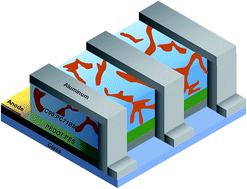Solution processed small molecule A–D–D′–D–A, denoted as BDT(CDTRH)2, consists of 2-ethylhexoxy substituted BDT (donor D’ unit) as the central building block and 3-ethylrhodanine (RH) as the end capped terminal (acceptor group) unit, with a π-linkage of cyclopentadithiophene (CDT) (donor D). We have designed and synthesized it, and we have investigated its optical and electrochemical properties, finding that its energy levels are compatible with the energy levels of fullerene derivatives for efficient exciton dissociation. This small molecule has been used as an electron donor along with PC71BM as the electron acceptor for the fabrication of solution processed small molecule bulk heterojunction (BHJ) solar cells. The BHJ solar cell processed with BDT(CDTRH)2 :
: PC71BM (1
PC71BM (1 :
: 1 wt ratio) showed a power conversion efficiency (PCE) of 4.58% with Jsc = 8.66 mA cm−2, Voc = 0.98 V and FF = 0.54. The high Voc value of the device has been attributed to the deeper HOMO energy level of BDT(CDTRH)2. The overall PCE of the device has been increased up to 6.02% (Jsc = 10.42 mA cm−2, Voc = 0.94 V FF = 0.62) when the blend was processed with 3% v/v CN/CF solvent. This increase is mainly due to an increase in Jsc and FF, which was linked to the increase in crystallinity and favorable nanomorphology of the active layer improving exciton dissociation and achieving a more balanced charge transport in the device.
1 wt ratio) showed a power conversion efficiency (PCE) of 4.58% with Jsc = 8.66 mA cm−2, Voc = 0.98 V and FF = 0.54. The high Voc value of the device has been attributed to the deeper HOMO energy level of BDT(CDTRH)2. The overall PCE of the device has been increased up to 6.02% (Jsc = 10.42 mA cm−2, Voc = 0.94 V FF = 0.62) when the blend was processed with 3% v/v CN/CF solvent. This increase is mainly due to an increase in Jsc and FF, which was linked to the increase in crystallinity and favorable nanomorphology of the active layer improving exciton dissociation and achieving a more balanced charge transport in the device.
